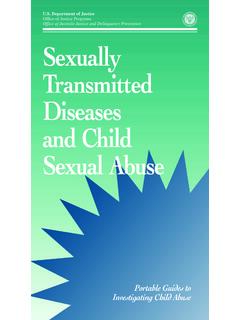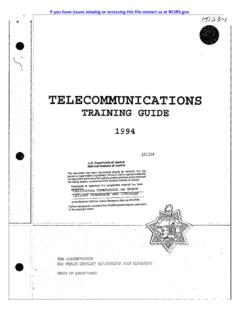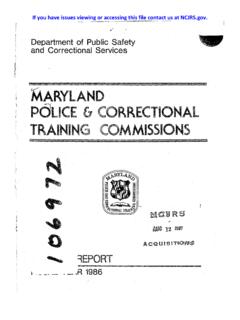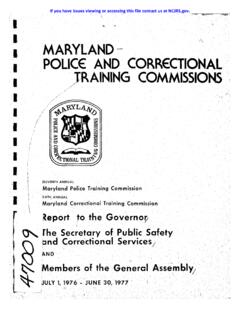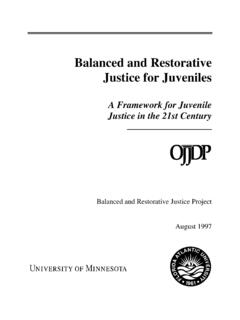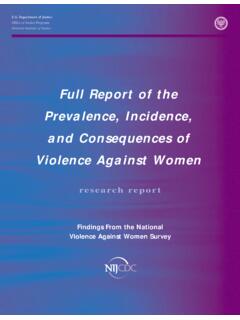Transcription of Pocket Guide for Police Response to Sexual Assault
1 NYSCASA would like to thank the following for their valuable time and efforts which made the development of this Guide possible . John Brooks, Senior Investigator, NY State Police Ken Buniak, New York State Internet Crimes Pocket Guide for Police Against Children Task Force Response to Sexual Assault Caran Curry, Legal Education Coordinator, New York Prosecutors Training Institute Tim Hardiman, Captain, New York Police Department, Queens South Task Force Alice Robinson, Mt. Sinai SAVI Program Terri Rolfe, Forensic Biologist, Arkansas State Crime Laboratory Amanda Voytek, Director of Counseling Programs, Kings County District Attorney's Office Jacqui Williams, Director of policy and Education, NYSCASA. Joseph Farrell, Criminal Justice Project Director, NYSCASA. National Institute on Drug Abuse NYS Crime Victims Board The Pocket Guide for Police Response to Sexual New York State Coalition Against Sexual Assault Assault is modeled on The Guide for Police Response 63 Colvin Avenue to Crimes of Sexual Assault which was produced by Albany, New York 12203.
2 The Police Officer Standards and Training Council Phone: (518) 482-4222. Fax: (518) 482-4248 (T. William Knapp, Executive Director), State of Website: Connecticut in 1998. Many thanks to the E-mail: POSTC ouncil. Overview acquaintance, colleague, spouse, ex-lover, or a family member). Sexual Assault is a crime that may be terrifying, Responding to Sexual Assault calls involves numerous humiliating, and life-threatening, regardless of who the complex and specialized procedures, all of which cannot victim is (teen, elder, prostitute, drug-addict, male, be covered in detail in this material. gay/lesbian). Keep in mind that the injuries from Sexual Assault are often not immediately apparent; some examples Accordingly, the following material is not intended to of this are post-traumatic stress disorder, internal injuries, provide complete information about conducting a Sexual sexually transmitted diseases, or unwanted pregnancy.
3 Assault investigation. It is not intended to replace training in any way, but to supplement training by serving as a convenient reference. General Investigation Information Officers both new to the job and experienced Sexual Assault cases generally can be categorized into two officers will find this Guide useful. types: a case in which the offender is known or a case in which the offender is unknown. In either case the key Officers should incorporate overall training, experience, issues to uncover are the identity of the offender, the and departmental protocols in all Sexual Assault element of force, and the issue of consent. investigations. If you have not had such training, consult your supervisor or your local District Attorney's office. Do not rely solely on this Guide . When the Offender is Known Because consent and/or use of force may become a key Introduction issue in cases in which the offender is known to the victim, evidence of force becomes a primary concern of the In Sexual Assault investigations, investigation.
4 Force may either be forcible compulsion or evidence and information about the physical helplessness. crime is gathered primarily from three sources: the victim; the A victim who knows the offender may or may not be able suspect; and the crime scene to identify the offender by full name, address, etc. For (including other witnesses). example, the victim may only know the offender by first Officers should thoroughly name. investigate all three sources, and any other available source of Identify and document the following information in order evidence or information. However, cases can be to determine if a photo line-up or other identification of successfully prosecuted even if the investigation reveals the suspect is warranted: that evidence is not available from all three sources. In responding to Sexual Assault complaints, every effort must The level and nature of the relationship between the be made to relieve victim's possible feelings of shame victim and the offender, including (1) how they have and/or self-blame.
5 In order to enable victims to provide known each other (2) type of contact they have had, the clearest, most complete information about the crime, depth of relationship, etc. efforts must be made to ensure that all victims are treated professionally and with dignity. Rape is not about sex, it is Detailed information concerning the Assault about power. Eight out of ten Sexual assaults are perpetrated by someone known to the victim (friend, Any evidence of physical injuries visible on the victim's body Attempt to locate the offender, begin an area search, or issue a broadcast if necessary. Check local sex offender Conduct a thorough investigation regardless of whether registry and if applicable, NYS and/or Federal DNA. the suspect is known or unknown. This will ensure that all database. possible information and evidence are gathered in every case. Inform the victim that it is in their best interest to have forensic evidence collected at either the area hospital's emergency department or Sexual Assault Examiners Unit.)
6 When the Offender is Unknown There the victim can be treated medically and given the appropriate prophylaxes (preventative treatment for In these Sexual Assault cases, a primary issue of the possible exposure to sexually transmitted infection and investigation is identifying the offender. The investigation pregnancy). should focus on obtaining as much information as possible in an effort to pinpoint a Evidence obtained during the investigation ( , from the suspect(s), including: victim's body or left at crime scene) may be useful in attempts to identify a suspect through the DNA data bank. A detailed physical description of the offender including, clothing, tattoos, facial features, identifying marks, distinctive walk, odors, etc. Information about Primary Responsibilities of First-Responding the offender's vehicle may also be helpful. Officer Obtain as much information as possible about the Attend to the victim offender's profile and compare to other offenders who Be careful not to stigmatize the victim have previously been arrested for a similar crime to determine whether a pattern exists, including: Preserve evidence on victim ( not taking a shower, nothing to drink, not brushing teeth, or removing any Method of approach clothes).
7 Secure and protect the crime scene Method of control Contact your local Rape Crisis Center Amount/type of force/restraint of victim Apprehend the offender if present Victim resistance Sexual dysfunction Contacting a Rape Crisis Center (RCC). According to NYS Executive Law 642 (b) all Police Type and sequence of acts departments shall provide victims of a crime defined in article 130. of penal law with the name, address and telephone number of the Offender verbal activity nearest Rape Crisis Center in writing. Offender attitudinal change Rape Crisis Center advocates are available 24 hours a day, seven days a week, every day of the year. They are available Items taken to meet victims at the hospital, the Police station, or District Attorney's office. They will respond to a call as soon as possible to speak with the victim, serving all clients Even in delayed reports, valuable evidence may still be regardless of age, race, ability, gender, or orientation.
8 Recovered from the crime scene(s). Rape Crisis Center advocates can explain legal and medical If a Recent Assault options and procedures to victims, and explain the details of making a Police report. Keep all 911 tapes of the report, or any other recordings. Due to confidentiality laws, a certified Rape Crisis Center advocate cannot disclose any information to anyone Ensure that the victim is safe. without the signed consent of the victim. In many cases, advocates are permitted to disclose victims' first names Arrange emergency medical assistance and only. transportation for the victim, as needed. Additional Response to the Victim Interviewing the Victim Ask if there is anyone else the victim would like to NYS Executive Law 642 states that all Police departments shall contact. provide a private setting for interviewing victims of a crime. Private setting means an enclosed room from which the occupants are not Assess any special needs of the victim, such as visible or otherwise identifiable, and whose conversations cannot be restoring mobility or the need for an interpreter.
9 Heard from outside the room. Document the identity of anyone whom the victim Victims may react in a variety of ways. Allow a Rape Crisis may have told about the Assault , or who may have seen Center advocate to remain with the victim during the or heard anything before, during or after the Assault . interview process. The NYS Executive Law 642 also states, Only (i) those persons directly and immediately Explain the local investigation process, what to expect, related to the interviewing of a particular victim, (ii) the and who will be involved. victim, (iii) a social worker, rape crisis advocate, psychologist or other professional providing emotional Be factual about the case. Avoid making predictions or support to the victim, unless the victim objects to the promises. presence of such persons and requests the exclusion of such person from the interview (iv) where appropriate, the parent or parents of the victim, if requested by the victim, If the Report is Delayed shall be present during the interview.
10 Delayed reporting is common and requires the same The attitude and conduct of the interviewing officer is key investigative methods. to gaining the victim's trust and cooperation. The victim will assess the officer's demeanor and language for Determine when the incident happened. reaction. Approach the victim in a respectful, supportive manner. Remain objective and non-judgmental. Document the reason for the delay, but be aware that questions about the delay may cause the victim to feel Explain the process for the blamed in some way. interview. Once the victim describes sex acts or parts of the The victim's ability to think clearly and to articulate what body, use the victim's own vocabulary to ask clarifying happened may be impeded by the Assault . Persons who questions. may be experiencing trauma will often recall and disclose information over a period of time. Officers may not get a It may be helpful to repeat the same words back to the full statement during the initial contact with the victim, victim immediately so as to give permission to especially if aspects of the Assault are unclear, if the victim continue using those words which the victim may feel was embarrassed about aspects of the crime, and/or if uncomfortable using ( , So he stuck his ** in your alcohol or drugs were involved.)
